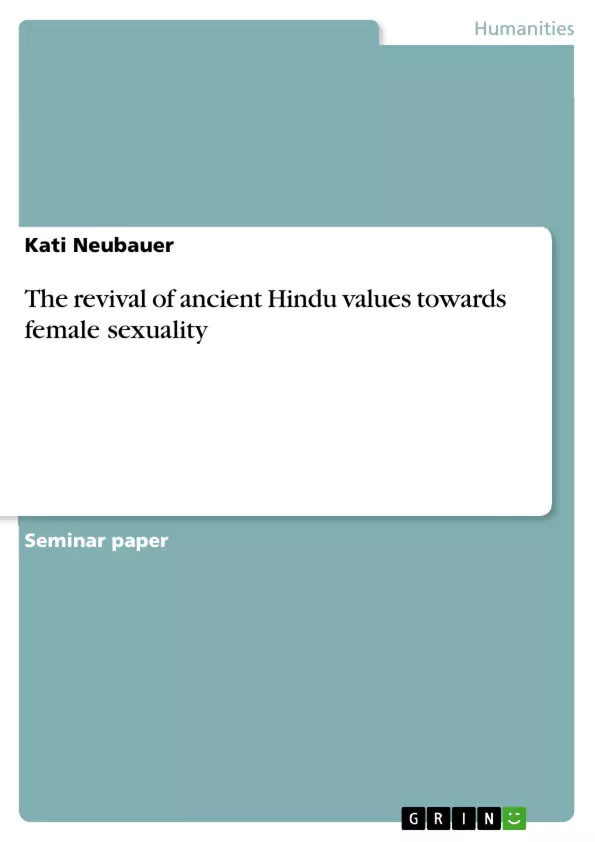In Hinduism the role of females is strictly defined and tied closely to the almost live lasting goal of childbearing. In the ancient texts the Ramayana, the Puranas, and the Mahabharata, female characters function as role models of feminine behavior and their expectations towards motherhood are displayed in the Indian society again today. This essay discusses how the ancient values made their way back in today’s Indian society and reveals the controversy that development accumulates.
Inhaltsverzeichnis (Table of Contents)
- The revival of ancient Hindu values towards female sexuality
- The early Vedic period
- The later Vedic period
- The sacred stories of Hinduism
- Sexual regulation in the Brahman caste
- Sexual understanding in lower casts
- The effect of the goal of producing children
- The impact of western influence on Hinduism
- The rise of feminism and the struggle for independence
- The clash of eastern and western values
- The Hindu Right and the ideal of motherhood
Zielsetzung und Themenschwerpunkte (Objectives and Key Themes)
This essay aims to explore the revival of ancient Hindu values concerning female sexuality in modern Indian society. It examines how these traditional beliefs, rooted in ancient religious texts and practices, have been reinterpreted and re-emphasized in the face of Western influence and changing social norms.- The role of women as mothers and their fertility as a central tenet of Hindu tradition.
- The impact of the patriarchal structure of Hindu society on the status and agency of women.
- The ways in which religious and cultural norms have shaped and restricted female sexuality.
- The influence of Western ideas, particularly those related to feminism and individual rights, on traditional Hindu beliefs and practices.
- The resurgence of traditional values, including the ideal of motherhood, as a response to the perceived threats posed by Western influence.
Zusammenfassung der Kapitel (Chapter Summaries)
The essay begins by examining the historical development of the Hindu view of female sexuality, tracing its roots to the early Vedic period. The author highlights the emphasis on fertility and the woman's role as a mother, arguing that these ideas were central to the concept of Samsara, the cycle of life and rebirth in Hinduism. The essay then explores the later Vedic period and the emergence of patriarchal structures, which placed men in positions of dominance and restricted women's agency. The author examines the impact of these social and religious norms on women's lives, particularly in the context of marriage and family. The essay continues by exploring how female characters in Hindu scriptures, such as the Ramayana and the Mahabharata, embody these traditional values and serve as role models for feminine behavior. The essay then examines the specific case of the Brahman caste and its emphasis on purity and ritualized sexual practices. It explores the tension between the idea of female fertility as sacred and the perceived pollution associated with menstruation and childbirth. The author discusses how these beliefs led to practices such as early marriage and limitations on contact between husbands and wives. The second half of the essay analyzes the impact of Western influence on traditional Hindu values. The author explores the rise of feminism and the struggle for independence in India, highlighting the clash between Western ideals of equality and individual rights and traditional Hindu beliefs about women's roles and responsibilities. The essay then examines the Hindu Right's response to Western influence and its emphasis on the ideal of motherhood as a symbol of national identity. The author argues that the Hindu Right's efforts to reassert traditional values were motivated by a desire to resist Western influence and maintain a sense of cultural and religious identity. The essay concludes by exploring the controversy surrounding the revival of ancient Hindu values, particularly in relation to issues such as child marriage and divorce. The author examines the legal and social reforms introduced by the British and the countervailing efforts by religious groups to uphold traditional values.Schlüsselwörter (Keywords)
This essay explores the interplay of Hindu tradition, female sexuality, motherhood, patriarchal structures, Western influence, feminism, and national identity in the context of modern India. Key themes include the historical development of the Hindu view of female sexuality, the impact of social and religious norms on women's lives, the clash of eastern and western values, and the revival of traditional values in the face of modernization.
Excerpt out of 9 pages
- scroll top
- Quote paper
- Kati Neubauer (Author), 2008, The revival of ancient Hindu values towards female sexuality, Munich, GRIN Verlag, https://www.grin.com/document/133134
Look inside the ebook



